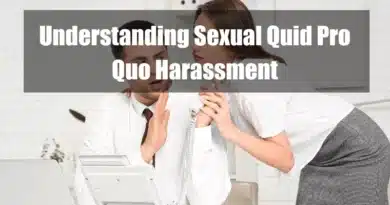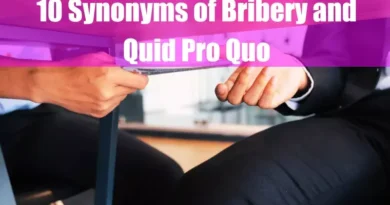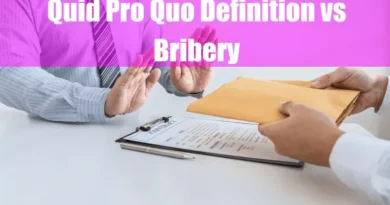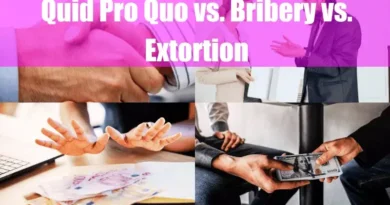Confirmation of Quid Pro Quo: A Comprehensive Analysis
Takeaways
| Key Points |
|---|
| Confirmation of quid pro quo involves proving that a reciprocal arrangement has occurred, where one party provides a favor or advantage in exchange for something of value, often in legal, corporate, or political contexts. |
| Key elements include a clear offer and acceptance, an exchange of tangible or intangible value, mutual agreement, and intent, which collectively establish the arrangement. |
| Legal and ethical concerns arise when such arrangements lead to bribery, favoritism, or inequities, necessitating adherence to laws, transparency, and ethical guidelines to maintain fairness and integrity. |
| Methods of confirmation include documentation, witness testimony, financial records, audio/video recordings, circumstantial evidence, and third-party accounts, all of which help substantiate the agreement. |
| Real-life examples, such as the Keating Five scandal, Operation Car Wash, or the 2019 college admissions scandal, underscore the importance of identifying and addressing quid pro quo arrangements to uphold ethical standards across industries. |
Introduction
Confirmation of Quid Pro Quo” involves the process of substantiating that a reciprocal arrangement has indeed taken place. Such an arrangement, where one party provides a favor or advantage in return for something of value, is fundamental in various contexts, including legal, corporate, and political spheres. Confirming such exchanges necessitates a thorough examination of the elements, legal and ethical concerns, and the methods employed to establish the occurrence of quid pro quo.
Elements of Quid Pro Quo
Offer and Acceptance
A clear offer from one party and acceptance from the other must be present. This can be verbal, written, or implied through actions. The clarity of the offer and acceptance is crucial in establishing the agreement.
Exchange of Value
The arrangement involves an exchange where each party receives something of value. This could be tangible, such as money, services, or goods, or intangible, such as influence, favorable treatment, or information.
Mutual Agreement
Both parties must agree to the terms of the exchange, whether explicitly stated or implied by their actions and circumstances. This mutual agreement forms the basis of the quid pro quo.
Intent
There must be an intention from both parties to engage in the exchange. Intent is often inferred from the context and behavior of the parties involved. This element is critical in differentiating between a quid pro quo arrangement and coincidental actions.

Legal and Ethical Concerns
Legal Standards
In legal contexts, confirming a quid pro quo often involves demonstrating that the exchange was deliberate and agreed upon. This is crucial in cases of bribery, corruption, or sexual harassment. The legal standards require clear evidence, including documentation, witness testimony, and behavioral evidence.
Courts and legal authorities look for specific elements that demonstrate the mutual agreement and value exchange. Legal precedents often guide the interpretation of quid pro quo arrangements, ensuring consistency in rulings.
Ethical Concerns
Ethically, quid pro quo arrangements can be problematic if they undermine fairness or integrity. For example, such arrangements might lead to favoritism, unfair advantages, or conflicts of interest in professional settings. Ethical concerns often arise when the arrangement is not transparent or benefits one party disproportionately.
Ethical reviews often consider the transparency and fairness of the arrangement, as well as its impact on trust and equity. Organizations and institutions may have ethical guidelines that explicitly address quid pro quo arrangements to prevent abuse and maintain integrity.
Methods of Confirmation

Documentation
Written agreements, emails, text messages, and other forms of communication can serve as evidence. These documents must clearly outline the terms of the exchange. Documentation provides concrete evidence that can be scrutinized and verified.
Witness Testimony
Testimonies from individuals who witnessed the agreement or actions of the parties involved can support the confirmation of quid pro quo. Witnesses can provide firsthand accounts that corroborate the details of the arrangement.
Behavioral Evidence
The parties’ actions, especially if they align closely with the terms of the exchange, can indicate the presence of a quid pro quo arrangement. Behavioral patterns that consistently reflect the terms of the agreement can be compelling evidence.
Financial Records
Financial documents, such as bank statements and payment receipts, can provide concrete evidence of an exchange. These records can trace the flow of money or other assets, linking them directly to the arrangement.
Audio and Video Recordings
Recordings can capture conversations and actions that reveal the quid pro quo arrangement. These recordings offer unaltered evidence that can be analyzed for intent and agreement.
Circumstantial Evidence
Sometimes, the context and timing of events can strongly suggest a quid pro quo arrangement, even if direct evidence is lacking. Circumstantial evidence can build a case by connecting dots that imply the existence of an arrangement.
Third-party Testimony
Testimonies from individuals not directly involved but aware of the arrangement can also be valuable. These third parties can provide insights or context that supports the confirmation.
Examples in Various Contexts

Political
A politician might offer political support or favorable legislation in exchange for campaign contributions or personal benefits. This type of arrangement often involves lobbying and campaign finance activities.
Corporate
An executive might give a vendor preferential treatment in exchange for personal kickbacks. Corporate quid pro quo arrangements can involve contracts, procurement processes, and vendor relationships.
Educational
A university official might offer admission or grades in return for donations or favors. These arrangements can undermine the fairness and integrity of admissions and grading processes in educational contexts.
Healthcare
A physician might refer patients to a specific clinic in exchange for financial incentives. In healthcare, quid pro quo arrangements can impact patient care and trust in medical professionals.
Non-profit Organizations
A charity might offer special recognition to donors in exchange for significant contributions. Non-profits must navigate ethical considerations to ensure transparency and fairness in their donor relationships.
Employment
An employer might offer job promotions in return for personal favors. Workplace quid pro quo arrangements can lead to hostile work environments and issues of discrimination and harassment.

Case Studies
Historical Case Studies
1. The Keating Five
This scandal involved five U.S. senators accused of improperly intervening on behalf of Charles Keating, chairman of the Lincoln Savings and Loan Association, in exchange for campaign contributions. The senators pressured regulators to overlook the association’s financial issues, leading to its collapse and significant financial losses for investors. The case highlighted the potential for political influence to undermine regulatory oversight.
2. ABSCAM Operation
In the late 1970s and early 1980s, the FBI conducted an undercover operation known as ABSCAM, which led to the conviction of several public officials for accepting bribes. The operation involved FBI agents posing as representatives of a fictitious Arabian company, offering money in exchange for political favors. The scandal exposed corruption and led to discussions about the ethics and legality of undercover operations.
Current Events
1. Brazil’s Operation Car Wash
Operation Car Wash (Operação Lava Jato) is a corruption investigation in Brazil that uncovered widespread bribery involving the state-controlled oil company Petrobras. Politicians, business executives, and public officials were implicated in receiving kickbacks in exchange for awarding contracts. The investigation has led to numerous arrests and convictions, significantly impacting Brazil’s political and business landscape.
2. 2019 College Admissions Scandal
Known as Operation Varsity Blues, this scandal involved dozens of individuals, including celebrities and business leaders, who paid large sums to secure their children’s admission to prestigious universities. The scheme included bribing exam administrators and college coaches to facilitate cheating on entrance exams and falsely designating applicants as athletic recruits. The scandal has led to increased scrutiny of college admissions processes and the influence of wealth.
Conclusion
Confirming a quid pro quo arrangement involves a multifaceted approach that requires gathering and analyzing various forms of evidence. Understanding the elements of offer and acceptance, exchange of value, mutual agreement, and intent is crucial. Legal and ethical concerns must be addressed to ensure fairness and transparency. By studying real-life examples and case studies, we can better navigate and prevent such arrangements in various fields.
FAQ
How can anonymous complaints be used to confirm quid pro quo harassment?
Anonymous complaints can be challenging to investigate, but they can still provide valuable leads. Employers should have a system to handle such complaints confidentially, allowing them to gather further evidence while protecting the complainant’s identity.
Can behavior observed outside the workplace be used to confirm quid pro quo harassment?
Yes, behavior outside the workplace can be relevant, especially if it involves work-related events or social functions where the harasser continues to exert their authority. Such evidence can help establish a pattern of behavior consistent with quid pro quo harassment.
How important is the timing of the alleged harassment in confirming quid pro quo?
Timing is crucial in confirming quid pro quo harassment. Correlating the timing of the harassment with job-related decisions or changes, such as demotions or denied promotions, can strengthen the case by showing a direct link between the harassment and the employment actions.
Can corroboration from other employees help in confirming quid pro quo harassment?
Corroboration from other employees who have witnessed the harassment or experienced similar behavior can be instrumental. Multiple testimonies can provide a broader context and reinforce the credibility of the allegations, making it harder for the harasser to dismiss the claims as isolated incidents.
What is “confirmation of quid pro quo”?
Confirmation of quid pro quo refers to the process of verifying that a mutually beneficial exchange has occurred, where each party’s benefit is clearly acknowledged and documented. This confirmation ensures that the transaction meets legal, ethical, and contractual standards.
How is “documented evidence” used to confirm a quid pro quo?
Documented evidence includes written agreements, receipts, emails, or contracts that detail the exchange. This tangible record helps verify that both parties agreed to specific terms, making it easier to confirm that the quid pro quo arrangement is transparent and legally sound.
What role does “written acknowledgment” play in the confirmation process?
A written acknowledgment is a formal statement by both parties recognizing the benefits exchanged. It serves as an official record that the quid pro quo was intentional and agreed upon, providing clarity and reducing disputes regarding the nature of the exchange.
How does “benefit disclosure” contribute to confirmation?
Benefit disclosure requires that all promised benefits or services are clearly communicated to all parties. By disclosing the exact nature and value of the exchange, organizations and individuals can confirm that the quid pro quo adheres to ethical standards and complies with regulatory requirements.
What is the significance of “transactional records” in confirmation?
Transactional records—such as financial statements, invoices, or digital logs—offer concrete proof of the exchange. These records help verify that the quid pro quo occurred as agreed, enabling audits and reviews to ensure accountability and compliance.
How does “audit trail” support confirming a quid pro quo?
An audit trail is a chronological record of all actions and communications related to the exchange. It provides a transparent pathway for verifying each step of the process, ensuring that internal or external auditors can review and confirm all aspects of the quid pro quo.
What is “mutual consideration,” and how is it confirmed?
Mutual consideration is the reciprocal value each party receives in an exchange. Confirmation of mutual consideration is achieved through documented agreements and clear valuations detailing the benefits on both sides, ensuring the exchange is equitable and enforceable.
How is “compliance verification” implemented to confirm quid pro quo exchanges?
Compliance verification involves reviewing all documentation and disclosures to ensure the exchange meets legal and ethical standards. This process typically includes internal audits, third-party reviews, and adherence to regulatory guidelines, confirming that the transaction was conducted fairly.
What does “record-keeping” entail in the context of quid pro quo confirmation?
Record keeping involves systematically archiving all documents, communications, and records related to the exchange. Maintaining accurate records supports transparency, helps resolve disputes, and provides a basis for confirming that the quid pro quo arrangement complies with contractual and legal obligations.
How can organizations ensure effective “verification processes” for quid pro quo?
Organizations can establish robust verification processes by developing clear policies for documenting and disclosing exchanges, implementing regular audits, training staff on compliance standards, and using secure digital systems to track all aspects of the transaction. These measures collectively ensure that each quid pro quo exchange is properly confirmed and maintained for accountability.









